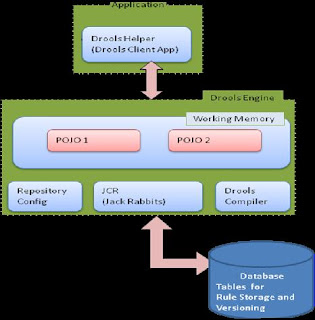Drools Guvnor BRMS(Business Rules Management System)
Overview of Drools:
Drools allow people to manage rules in a multi user environment. It is a single point to allow change of business rules in a controlled fashion, with user friendly interfaces.
Why Drools?
Drools rule engine is required to fulfill following requirements:
Drools allow people to manage rules in a multi user environment. It is a single point to allow change of business rules in a controlled fashion, with user friendly interfaces.
Why Drools?
Drools rule engine is required to fulfill following requirements:
- Manage versions/deployment of rules.
- Support multiple users of different skill levels to access and edit rules.
- Externalization of the business rules management thus providing the ease of editing and deploying/ updating of the business rules at Runtime. This avoids the redeployment of the any component upon a business condition change which will certainly results in to minimizing application redeployment efforts and costs.
Drools BRMS Features: Drools BRMS Features are as following -
- Drools rule engine is open source.
- Drools Rule Customization is done with ease by business users like business analyst as well as technical users like system users and developers.
- Drools support Decision Table (MS Excel /CSV Format) which will ease rule development for system user with less technical knowledge.
- Drools supports business rules as well as technical rules.
- Drools rule engine supports versioning of rules.
- User authorization support based on different skill levels limiting the access to view, edit and deploying rules.
- Drool Rule Language (DRL) has a very Java-like syntax and uses the Java Bean specification.
- Multiple rule editors are supported like GUI, text, etc.
- Categorization and modularization of rules is supported
- Supports the packaging of rules based on the rule categories(Logical grouping of Rules)
- Dynamic Rule Updation is possible.
- Test cases can be written to test the rules.
- Drools support templates. Drools allow you to set up templates that may then be merged with data. Similar to the decision table but more powerful like we can apply multiple templates to the same data.
- Drools Helper (Client) component using the DroolsAPI.It is interacting with the Drools Engine.
- Drools Rule Engine which executing the BusinessRules (.drl, .dsl…..format).These rules were built based upon the Facts (POJO Beans) and having the business logic.
- Drools Engine maintains a Working Memory. This memory will store the Facts (components).The Rule engine internally using the RETE Algorithm. The algorithm having Pattern Matching of Facts and Rules which stored in the DB which increases efficiency of Rule Engine operations.
- Drools Specific tables will be stored in Database which will contain Rules and versioning information.
This is just introduction.. More is on the way... Keep looking!!!
Please leave your comments and suggestions below...



Comments
Post a Comment